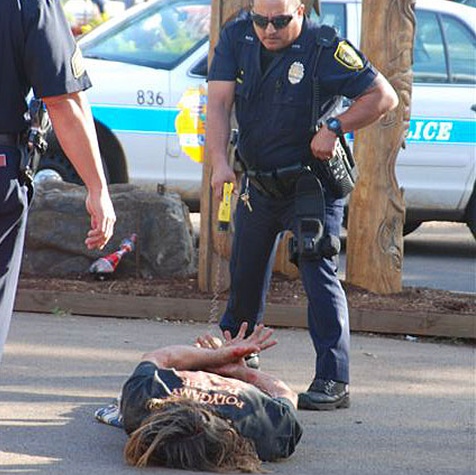SOURCE: JONATHAN JAY jonathan@DAkauai.com
POSTED: 27 JULY 2008 - 7:30am HST
Kauai Taser Implementation

image above: University of Florida student Andrew Meyer was tasered for asking John Kerry a question.
See the YouTube "Don't Taze be bro!" video here http://www.youtube.com/watch?v=6bVa6jn4rpE
by Jonathan Jay on 27 July 2008 The following is a letter submitted to the Chief of the Kauai Police Department: Aloha Chief Darryl Perry, |
SOURCE: JUAN WILSON juanwilson@mac.com
POSTED: 26 JULY 2008 - 4:00pm HST
Chief Perry: Tasers in use next month
|
SOURCE: JUAN WILSON juanwilson@mac.com
POSTED: 26 JUNE 2008 - 4:00pm EST
Unjustified Taser use on helpless people

image above:High voltage danger sign
by Jonathan Turley on 1 July 2008 inb http://jonathanturley.org ;In Dayton, Ohio, citizens are upset over an incident where a blind woman, Denise Harris, 49, suffering from cancer was Tasered by police — apparently while she was on the floor. The police insist that they needed to Taser her “to control her hand movement.”Family and neighbors insist that they told police that she was sick and was afraid. The initial police statements indicate that she was hit with
the Taser to facilitate cuffing — a very problematic rationale. In another entry into the abuse of Tasers, this video shows police using a Taser to the neck of a pregnant mother after throwing her on her stomach to the ground. The woman clearly needed to be restrained, but it is hard to seriously suggest that a Taser was needed given her condition. Once again, this widely available technology is being used freely by officers as an alternative to physical restraining techniques. This officer was clearly capable to restraining this upset woman without the use of a Taser, but took the increasingly common approach of a Taser hit. In yet another Taser abuse video, a Utah officer is shown telling a man to turn around and then Tasering him in the back after the driver refused to sign a ticket — while the man’s pregnant wife screams from inside the car. The video shows Trooper John Gardner firing on Jared Massey during a traffic stop on on Sept. 14th. The roughly 10-minute video shows Gardnerpulling Massey over for speeding. When Massey refuses to sign the ticket, Gardner gets upset when Massey refuses to sign the ticket while arguing its basis. Gardner tells him to turn around and fires into his back. Massey can be heard saying “I don’t know why you’re doing this,” and “read me my rights.” His screaming pregnant wife is ordered by Gardner back into the car and when another officer appears, Gardner says “he took a ride with the Taser.” Recently uncovered video of a disabled British Columbia man being shocked with a Taser by a Royal Canadian Mounted Police officer has sparked controversy and once again brought the use of such weapons into the limelight. |
SOURCE: JUAN WILSON juanwilson@mac.com
POSTED: 26 JULY 2008 - 4:00pm HST
On Police Use Of Force

image above: Police sudue suspect wearing "Polygamy" tee-shirt
by Peter Moskos on 10 May 2008 in speculativenonfiction.blogspot.com |
see also:
Island Breath: Dangers of Tasers 6/12/08
Island Breath: Police Militarization 5/7/08
Island Breath: KPD Overreact in Hanapepe 5/6/08
Island Breath: Protect and Serve - Not terrify! 4/5/08
Island Breath: Lingle Plan for Police State 9/22/07